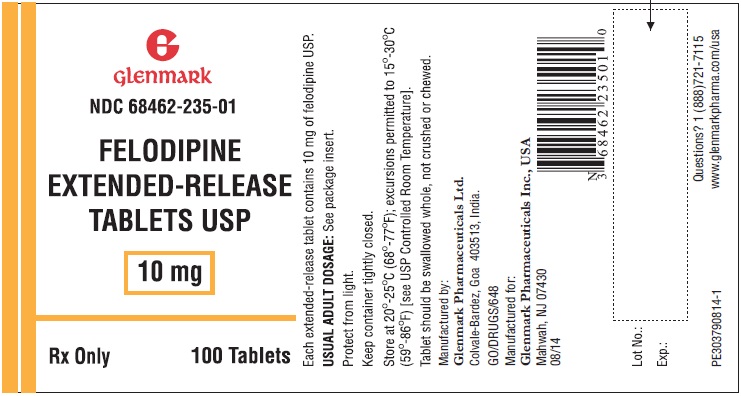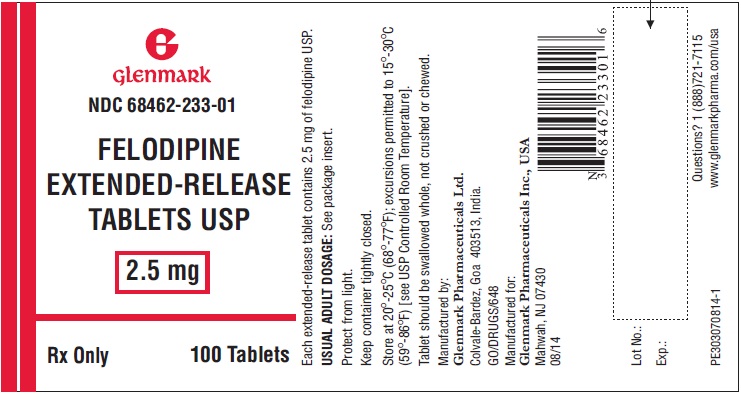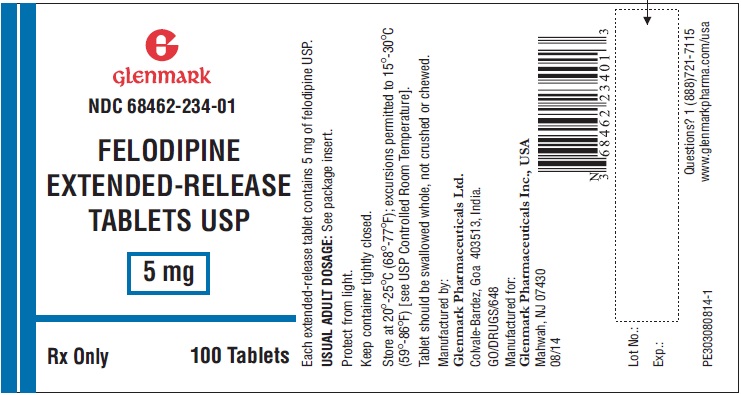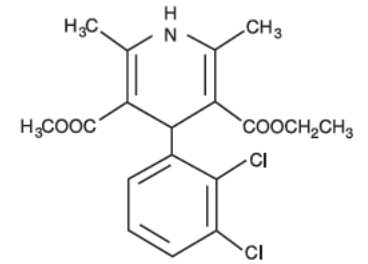Drug Catalog - Product Detail
FELODIPINE ER TB 10MG 100
| NDC | Mfr | Size | Str | Form |
|---|---|---|---|---|
| 68462-0235-01 | GLENMARK PHARMACEUTICALS | 100 | 10MG | TABLET |
PACKAGE FILES





Generic Name
FELODIPINE
Substance Name
FELODIPINE
Product Type
HUMAN PRESCRIPTION DRUG
Route
ORAL
Application Number
ANDA090365
Description
DESCRIPTION Felodipine extended-release tablets USP are a calcium antagonist (calcium channel blocker). Felodipine is a dihydropyridine derivative that is chemically described as ± ethyl methyl 4-(2,3-dichlorophenyl)-1,4-dihydro-2,6-dimethyl-3,5-pyridinedicarboxylate. Its molecular formula is C 18 H 19 Cl 2 NO 4 and its structural formula is: Felodipine USP is a slightly yellowish, crystalline powder with a molecular weight of 384.26. It is insoluble in water and is freely soluble in dichloromethane and ethanol. Felodipine is a racemic mixture. Felodipine extended-release tablets provide extended-release of felodipine. They are available as tablets containing 2.5 mg, 5 mg, or 10 mg of felodipine for oral administration. In addition to the active ingredient felodipine, the felodipine extended-release tablets 2.5 mg, 5 mg and 10 mg contain the following inactive ingredients: hydroxypropyl cellulose, hypromellose, kaolin, lactose monohydrate, microcrystalline cellulose, polyoxyl 40 hydrogenated castor oil, sodium stearyl fumarate, Opadry Green 20B51525 (2.5 mg), Opadry Pink 20B84706 (5 mg) and Opadry Red 20B55372 (10 mg). Opadry Green 20B51525 consists of hypromellose, hydroxypropyl cellulose, macrogol, titanium dioxide, D&C Yellow No. 10 Aluminium Lake, FD&C Blue No. 2 Aluminium Lake and ferric oxide yellow. Opadry Pink 20B84706 consists of hypromellose, hydroxypropyl cellulose, macrogol, titanium dioxide, ferric oxide red and ferric oxide yellow. Opadry Red 20B55372 consists of hypromellose, hydroxypropyl cellulose, macrogol, titanium dioxide, ferric oxide red and ferric oxide yellow. structure
How Supplied
HOW SUPPLIED Felodipine extended-release tablets USP, 2.5 mg are green colored film coated, circular shaped, biconvex tablets engraved with “G19” on one side of the tablet and plain on the other side. They are supplied as follows: Bottles of 90 NDC 68462-233-90 Bottles of 100 NDC 68462-233-01 Bottles of 1000 NDC 68462-233-10 Unit dose packages of 100 (10 x 10) NDC 68462-233-11 Felodipine extended-release tablets USP 5 mg are light pink colored film coated, circular shaped, biconvex tablets engraved with “G19” on one side of the tablet and “5” on the other side. They are supplied as follows: Bottles of 90 NDC 68462-234-90 Bottles of 100 NDC 68462-234-01 Bottles of 1000 NDC 68462-234-10 Unit dose packages of 100 (10 x 10) NDC 68462-234-11 Felodipine extended-release tablets USP 10 mg are brown colored film coated, circular shaped, biconvex tablets engraved with “G19” on one side of the tablet and “10” on the other side. They are supplied as follow: Bottles of 90 NDC 68462-235-90 Bottles of 100 NDC 68462-235-01 Bottles of 1000 NDC 68462-235-10 Unit dose packages of 100 (10 x 10) NDC 68462-235-11 Storage: Store at 20 o -25 o C (68 o -77 o F); excursions permitted to 15 o -30 o C (59 o -86 o F) [see USP Controlled Room Temperature]. Keep container tightly closed. Protect from light.
Indications & Usage
INDICATIONS AND USAGE Felodipine tablets are indicated for the treatment of hypertension, to lower blood pressure. Lowering blood pressure lowers the risk of fatal and non-fatal cardiovascular events, primarily strokes and myocardial infarctions. These benefits have been seen in controlled trials of antihypertensive drugs from a wide variety of pharmacologic classes including felodipine. Control of high blood pressure should be part of comprehensive cardiovascular risk management, including, as appropriate, lipid control, diabetes management, antithrombotic therapy, smoking cessation, exercise, and limited sodium intake. Many patients will require more than 1 drug to achieve blood pressure goals. For specific advice on goals and management, see published guidelines, such as those of the National High Blood Pressure Education Program’s Joint National Committee on Prevention, Detection, Evaluation, and Treatment of High Blood Pressure (JNC). Numerous antihypertensive drugs, from a variety of pharmacologic classes and with different mechanisms of action, have been shown in randomized controlled trials to reduce cardiovascular morbidity and mortality, and it can be concluded that it is blood pressure reduction, and not some other pharmacologic property of the drugs, that is largely responsible for those benefits. The largest and most consistent cardiovascular outcome benefit has been a reduction in the risk of stroke, but reductions in myocardial infarction and cardiovascular mortality also have been seen regularly. Elevated systolic or diastolic pressure causes increased cardiovascular risk, and the absolute risk increase per mmHg is greater at higher blood pressures, so that even modest reductions of severe hypertension can provide substantial benefit. Relative risk reduction from blood pressure reduction is similar across populations with varying absolute risk, so the absolute benefit is greater in patients who are at higher risk independent of their hypertension (for example, patients with diabetes or hyperlipidemia), and such patients would be expected to benefit from more aggressive treatment to a lower blood pressure goal. Some antihypertensive drugs have smaller blood pressure effects (as monotherapy) in black patients, and many antihypertensive drugs have additional approved indications and effects (eg, on angina, heart failure, or diabetic kidney disease). These considerations may guide selection of therapy. Felodipine tablets may be administered with other antihypertensive agents.
Dosage and Administration
DOSAGE AND ADMINISTRATION The recommended starting dose is 5 mg once a day. Depending on the patient's response, the dosage can be decreased to 2.5 mg or increased to 10 mg once a day. These adjustments should occur generally at intervals of not less than 2 weeks. The recommended dosage range is 2.5-10 mg once daily. In clinical trials, doses above 10 mg daily showed an increased blood pressure response but a large increase in the rate of peripheral edema and other vasodilatory adverse events (see ADVERSE REACTIONS ). Modification of the recommended dosage is usually not required in patients with renal impairment. Felodipine should regularly be taken either without food or with a light meal (see CLINICAL PHARMACOLOGY, Pharmacokinetics and Metabolism ). Felodipine should be swallowed whole and not crushed or chewed. Geriatric Use - Patients over 65 years of age are likely to develop higher plasma concentrations of felodipine (see CLINICAL PHARMACOLOGY ). In general, dose selection for an elderly patient should be cautious, usually starting at the low end of the dosing range (2.5 mg daily). Elderly patients should have their blood pressure closely monitored during any dosage adjustment. Patients with Impaired Liver Function - Patients with impaired liver function may have elevated plasma concentrations of felodipine and may respond to lower doses of felodipine; therefore, patients should have their blood pressure monitored closely during dosage adjustment of felodipine (see CLINICAL PHARMACOLOGY ).
